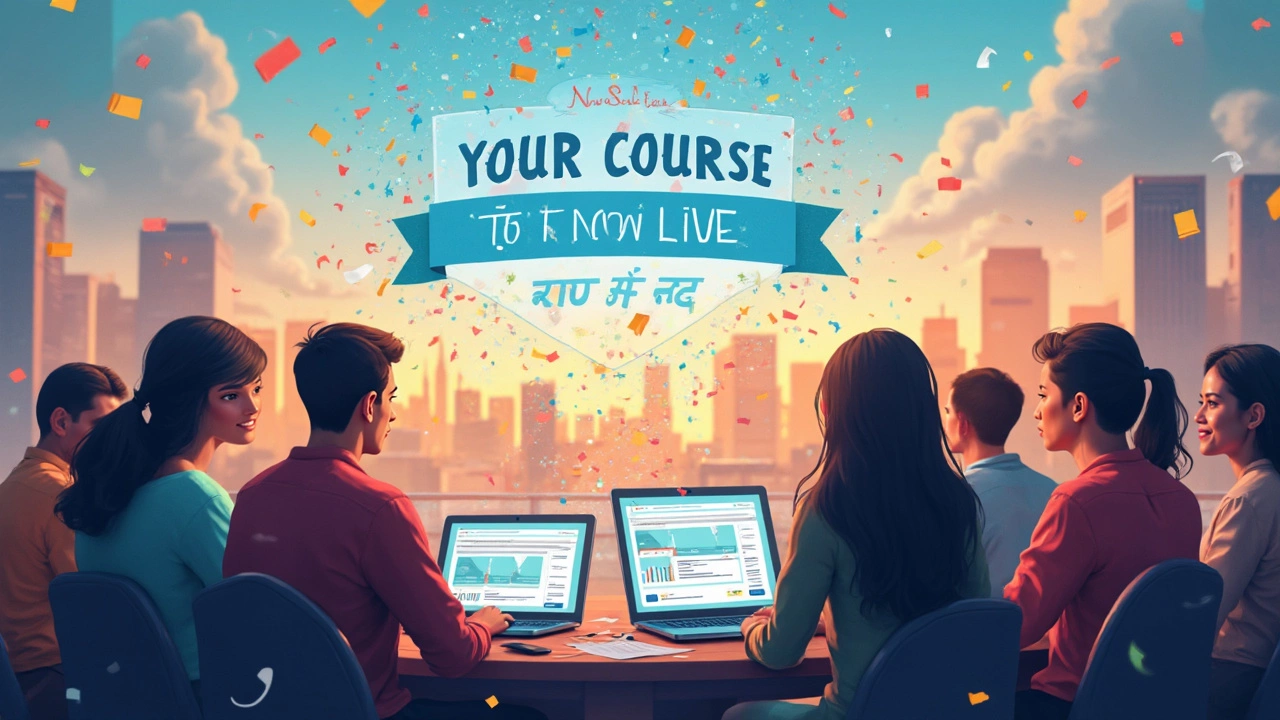Australia just saw more than a million people sign up for new online courses in the past year. That’s not random—eLearning platforms are now the go-to for anyone wanting to brush up on coding, photography, or even ancient history. I get it, the idea of launching your own eLearning site sounds massive. But here’s the kicker: with the right moves, it’s way more possible than most people think. Too many folks get tied up in thinking you need crazy funding or a Silicon Valley zip code. Not true at all. Some of the most successful platforms were bootstrapped from bedrooms and local cafés, running over laptops powered with a flat white and big dreams. Let’s get to the details nobody shares—the steps, the pitfalls, and the tricks that actually matter if you want to turn this idea into a real thing.
Choosing Your Niche and Defining Your Purpose
Get this wrong, and the rest just doesn’t work. The web is swimming with generic eLearning platforms that get zero traction because they try to teach everything to everyone. If you want attention, start by laser-focusing on your niche. Forget about being the next Coursera or Udemy—they already exist. Instead, go specific. Think "eco-friendly gardening for city dwellers," or "drone piloting for real estate pros."
Why? Because specificity builds trust. In 2024, a Sydney-based language teacher launched an eLearning platform just for Mandarin-speaking migrants learning Aussie slang and culture. She didn’t chase a global audience. Instead, she built a tight local community that kept growing—not because she was flashy, but because she solved a real problem no one else cared about. If you’re stuck, ask yourself: What’s missing in the subjects you care about? What problem drives you crazy that nobody’s fixing? Start there.
Back it up with data. Google Trends will tell you what’s hot (or fizzling out). Join Facebook groups, subreddits, and Discord servers related to your idea, and just listen. Are people asking the same questions over and over? Bingo—there’s your first course idea. The more you talk to your potential learners early, the bigger your advantage later. Here’s a quick checklist before you lock in your niche:
- Can you easily find forums or social groups discussing it?
- Are there existing online courses? If so, what are they missing?
- Do you already know someone who’d benefit from your platform?
- Can you see yourself making 10+ courses about this topic?
Commit to that niche, and suddenly, everything feels way less overwhelming. When you speak to a specific group, your marketing clicks, your content resonates, and your platform grows by word of mouth—no ad budget needed.
Planning Your Courses and Platform Structure
Once you’ve got your purpose dialed in, planning your courses is next. Don’t just upload a bunch of boring PowerPoints and call it a day. People expect way more: clear videos, quizzes, discussion forums, even downloadable checklists or guides. You need a learning path that gets people from A to Z—with as little confusion as possible. Think about it: why do people actually finish a course? It’s not just about pretty graphics. It’s because each lesson is connected, building up their skills or knowledge in bite-sized, doable steps.
Story matters here. Each course should feel like a personal journey, not just a data dump. Want a pro tip? Map your lessons on sticky notes across your kitchen table. Group similar topics together and look for any gaps. If you’ve got friends or mates who fit your target audience, run your plan past them. Ask: “Would you actually pay for this?” Their honest reactions will say more than any online survey.
You’ll also want to check what format your audience prefers. Some people love podcasts, others are all about short videos or interactive assignments. The Australian eLearning market loves visually-rich, bite-sized tutorials—think five to ten-minute chunks, not hour-long marathons. See what’s popular in your niche, then make it better or more accessible.
Now, platform structure. You don’t need to reinvent the wheel—platforms like Teachable, Kajabi, or Thinkific let you build a pretty slick site without coding. Even WordPress with a plugin like LearnDash works for many. If you’re a coder and want full control, you might build your own using React or Django, but don’t underestimate how much time and support this takes. Platform choice can depend on:
- Your budget (monthly SaaS costs or a DIY build)
- Your technical chops (are you ok tweaking code, or do you want drag-and-drop simplicity?)
- The need for features like quizzes, certificates, community forums, and analytics
- Scalability—will it break if 10,000 people sign up?
Great platforms are simple at first. Launch with your core content and expand as your community grows. Focus on crystal-clear navigation—no one wants to hunt around for their next lesson. Early feedback is gold. Use online surveys or quick Zoom calls to find out what’s missing or confusing. Fun fact: the highest-rated Aussie eLearning platforms in 2025 all used student feedback to improve their course layout within the first three months.

Building Content that Grabs Attention and Delivers Value
This is where most people freeze up. "But I’m not a teacher," or "I don’t have fancy equipment." Good news: most learners care more about clarity and authenticity than Hollywood production values. Here’s what actually works: screen recording for walkthroughs, simple slides for big concepts, and snippets of you talking directly to the camera. You can shoot killer video on your phone if you’ve got good lighting and a half-decent microphone. Platforms like Canva make lesson slides look schmick with zero design skills.
When you build your first course, break each module into tiny, focused lessons. If something takes more than 8 minutes to cover, it probably needs to be split up. Include short quizzes after each lesson—even two quick multiple-choice questions do the trick. And always add a call to action: "Try this now," "Share what you learned," or "Download the cheatsheet." Learners want to feel like they’re moving forward, not just drowning in info.
Mix up your media. Throw in videos, audio lessons, diagrams, short readings, and downloadable templates. If your topic suits it, add interactive elements—like code playgrounds for beginner programmers or photo assignments for budding landscape photographers. And don’t skimp on real-world examples. People love seeing exactly how what they’re learning fits into daily life or their job.
Make your platform social. Every successful eLearning site in 2025 has a community element—private Facebook groups, discussion boards, or even weekly Zoom Q&As. Not everyone will join, but the ones who do become your core superfans. A guy in Melbourne tripled his course sales last year by adding a simple Discord server where students could swap tips and small wins.
Here’s a table with some of the most-used tools for eLearning content creators in Australia this year:
| Tool | Purpose | Estimated Monthly Cost |
|---|---|---|
| Canva | Slides & graphics | AU$17 |
| ScreenPal (Screencast-O-Matic) | Screen recording | AU$10 |
| Zoom | Live sessions | Free / AU$21 |
| Audacity | Audio editing | Free |
| Teachable | Hosting/courses | AU$59 |
| Discord | Community | Free |
Don’t wait for perfect. If your first videos aren’t Oscar material, that’s fine. Your learners care more about your knowledge and how you help them solve their problems. And always keep a notepad handy—student questions and feedback will give you your best ideas for follow-up content.
Launching Your Platform and Building Your First Learner Community
The first launch is nerve-wracking. It’s tempting to wait until everything’s flawless, but trust me—nobody gets it perfect on day one. Launch to a small group first. This is called a soft launch, and in the eLearning world, it’s your safety net. Reach out to friends, colleagues, local Facebook groups, or even Meetup communities in Sydney who fit your target audience. Offer free or discounted access in exchange for honest feedback.
During your soft launch, watch where users struggle or drop off. Are the lessons too long? Is the signup process clunky? Use tools like Google Analytics or Hotjar to see real user behavior. Patch up problems fast and keep improving. Nothing builds loyalty like real responses to feedback.
When it’s time to open to the public, don’t rely on social media alone. Build an email list from day one. Emails get delivered and seen (unlike social posts swallowed by the algorithm). Offer a free mini-course or a downloadable resource in exchange for an email address.
And here’s the thing: your best marketing isn’t Facebook ads or fancy SEO. It’s word of mouth from your first happy students. Ask for testimonials, get reviews, and share real stories (with permission). TikTok and Instagram stories work wonders for behind-the-scenes updates or quick tips from your courses. Super handy for building FOMO and trust.
If your niche is local (like helping Sydneysiders prep for the NSW HSC), reach out to local newspapers, radio spots, or even community groups for some extra buzz. Don’t be shy about partnerships. Team up with local experts to co-host sessions or cross-promote your courses—audiences overlap more than you think.
Finally, keep your community sticky. That means monthly Q&As, regular emails, progress check-ins, and new lesson drops—anything that keeps learners coming back. Consistent updates show you’re real, invested, and not just cashing in on the trend.

Monetisation: How to Make Your eLearning Platform Profitable
Building the platform is only half the game. You need a plan to make money—without scaring off your audience. The good news is, you’ve got options. Most folks start with pay-per-course pricing. That’s simple: users pay for what they take. This works best for hands-on, skill-based courses (like coding or marketing) where people know the value up front. The average price of a high-quality online course in Australia in 2025 is between AU$55 and AU$250—more if you’re offering industry certificates.
But that’s not all. Subscription models—like Netflix for courses—are blowing up. For as little as AU$14 a month, students get access to everything. This keeps your revenue steady and creates loyal, binge-learning customers. Some platforms mix the two: offer basic courses for free or cheap, then upsell advanced tracks on a monthly plan.
You can also use a freemium model. Give away a couple of lessons or a mini-course to build trust, then charge for the full program or advanced content. This works well for new brands, since people always want a taste before clicking "buy".
Corporate partnerships are big in Australia too. Companies pay for access to premium content for their staff—especially in compliance, tech, and soft skills. If your content fits, pitch to HR managers. You might land a contract worth thousands up front.
Don’t forget about affiliate income. If you recommend tools or books, use affiliate links. Just keep it honest—people can spot a cash grab a mile away.
Here’s a quick table showing common eLearning revenue models in 2025, with typical pricing ranges for Australia:
| Monetisation Model | Description | Typical Australia Pricing |
|---|---|---|
| start eLearning platform | Launch & earn from individual course sales | AU$55 - AU$250 per course |
| Subscription | Access to all courses for monthly fee | AU$14 - AU$39/month |
| Freemium | Free access to basics, pay for premium | Varies (AU$0 - AU$299+ for premium) |
| Corporate Sales | Bulk packages for teams/companies | AU$500 - AU$15,000+/yr |
Keep an eye on cash flow. Watch your numbers weekly—not just sales, but churn (the number of customers leaving), refund rates, and where learners drop out. Make changes fast. And reinvest your first wins—improve your equipment, upgrade your site, or create fresh content.
If you stick with it and keep putting learners first, your eLearning platform won’t just make money—it’ll actually help people. That’s about as rewarding as it gets.






Write a comment: